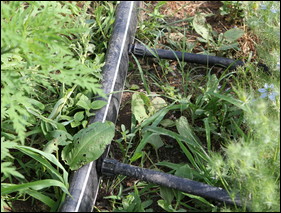 An irrigation system is an effective means of watering lawns and gardens. |
All plants need water. They can grow only as fast as they have water for cell growth. Trees in the rain forest grow so fast because of ever-available water and high-humidity. In the home garden, one deep watering is worth a peck of sprinklings. Most plants require 1 inch of rainfall each week; the sprinkler should deliver 1 inch of water before you turn it off. During times of drought, very hot, dry or windy weather, this should be increased to two to three times a week, although water costs and conservation regulations may make this impractical.
Water is a valuable resource, not to be wasted. Overwatering doesn’t help plants. Excess water percolates through the spill into the lower levels. Sprays evaporate into the air. Furthermore, plants, especially trees and shrubs, can die from too much water. Roots need air or they smother and rot. A good watering that is allowed to soak through then dry out is somewhat preferred to frequent light waterings. Only swamp plants like constantly wet feet.
Light sprinklings don’t reach the deeper roots. Sprinklings also encourage the plants to put out new roots near the surface of the soil. These roots are shallow, and, so, very susceptible to drying out as the top layer of soil heats up. The lower levels remain quite constant in temperature.
A lot of water stimulates “soft” growth. Lack of water causes plants to “harden.” When plants harden, their outer covering becomes tough and leathery. Both leaves and bark are affected.
Water is one of many triggering mechanisms by which the plants know what seasons are coming, especially in tropical regions where temperature variations are less pronounced. When the rains come (usually in the spring), the plants know to begin putting out leaves and flowers. When the rains diminish (usually in late summer or fall), the plants begin to “harden” to conserve moisture and protect their cells from the winter cold to come. Home watering should mimic the seasons. It is wise to water more often in May and June when it is dry than in September and October. All plants, however, should go into winter with moisture in the soil. One good late-fall soaking is the most desirable way to do this, especially if the weather has been unseasonably dry.
Some good general rules to consider when deciding if watering is needed are: (1) if the soil is dry 6 inches down; (2) if there has not been a good rainfall recently that soaked in and did not run off; (3) if the plant leaves droop, which indicates water stress; (4) if a water moisture meter reads dry.
Credit: www.mothersgarden.net




























